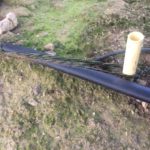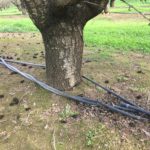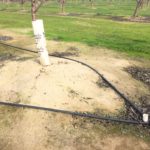- Author: Cameron Zuber
While conducting surveys across Merced County, I have noticed diverse ways growers secure the ends of irrigation tubing. Many are attached using some type of stake made of wood or PVC in which the tubing is tied. Other orchards have the lines wrapped around a tree and used as an anchor for the line. Finally, some of them are staked directly into the ground.
Irrigation tubing moves because of expansion and contraction of the plastic caused by temperature changes, as well as, from the water and air moving through the irrigation system. Securing the tubing creates tension that helps prevent the tubing from moving. These keeps the emitters and microsprinkers in place which helps maintain good irrigation efficiency.
There are a few problems with securing the tubes. The first is the added cost and time to first secure the tubing and then maintain how the tubing was secured. Secondly, the lines may contract after fixing, which can pull them off the riser. Finally, the lines, if wrapped too tight, can cut into and girdle the tree. All of these are preventable.
If you do choose to secure the end of your irrigation tubing, below are some considerations to take into account:
- Leave some slack in the tubing: Due to changes in temperature, plastic tubing expands and contracts. When tightly secured tubing contracts, coupling points may become undone (e.g., at the riser) or may cause the plastic in the tubing to stretch, creating weak points that may eventually break.
- Be wary of using trees to secure tubing: While this may cut down on supply costs, make sure it does not begin to girdle the tree.
- Do it right: Since you are taking the time (and money) to secure your tubing, be sure to do it right. There is a lot of power in the contraction and expansion of irrigation tubing, and a poorly installed system will eventually fail.
- Secure irrigation tubing in the winter: Securing tubing on colder days prevents problems related to contraction. Cold tubing that does not have enough slack will just expand and create the slack that was needed. Hot tubing that does not have enough slack will contract and cause problems, as described above
- .
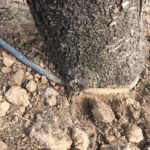
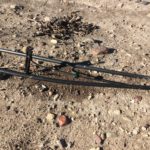
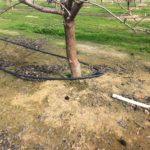
Whether or not you decide to secure your irrigation tubing is up to you. Ultimately, the end goal is a well-irrigated field. Securing irrigation tubing, if done right, is just one thing to help accomplish that goal.
From the Almond Doctor: https://ucanr.edu/sites/sayalmond/The_Almond_Doctor/

- Author: Ben Faber
Microirrigation (drip, microsprinkler, fan jet) applies water through small openings and can easily be prone to clogging. For this reason, filtration is used to avoid introducing sediments into the system and all fertilizers are injected before the filters to avoid their clogging the system. Before introducing a mixture of fertilizers into an untried system a jar test should be performed to make sure there are no chemical interactions between the irrigation water and anything that is introduced that might cause precipitation and eventual clogging. Depending on the size of emitters openings, some types are more or less prone to clogging. Anytime you use a new brand of fertilizer, make sure you do a jar test, because there have many problems in the past of just reading the label, seeing that it is soluble and then finding out to one’s horror that every emitters is clogged. For prevention of chemical and biological clogging see the article by Schwankl in this newsletter.
Microirrigation systems work best with pre-solubilized, liquid fertilizer solutions. In season application of dry fertilizers over the top of micro systems is very inefficient since only a fraction of the soil surface receives water necessary to solubilize the dry material. Very finally ground materials, such as gypsum or potassium sulfate can be suspended in solution by injectors if the materials meet the specifications of the irrigation system. The injectors continuously agitate the materials in the irrigation water to prevent settling out. The irrigation systems should be flushed after every use to prevent the materials from settling the ends of irrigation lines after the system is turned off.
Microirrigation can supply small, frequent does of nutrients throughout the growing season. Plant roots proliferate in the emitter wetted area which makes for a more active zone for taking up nutrients. Many growers have found that nitrogen fertilizer rates can be reduced due to the increased efficiency of uptake. Nutrients that require a larger root system than the microirrigation wetted pattern might need more frequent application than under sprinkler or furrow, such as potassium or micronutrients. Leaf tissue testing is a helpful too to adjust fertilizer applications, especially with a new system.
All pressurized irrigation systems require a certain amount of time to fill all laterals with water and achieve operating pressure. Injected fertilizer also requires a certain amount of time to distribute throughout the irrigation system. The ideal time to inject fertilizer is in the middle of the irrigation set. If injection takes place before the system is fully pressurized, there is a lack of uniformity if fertilizer placement (see http://cesantaclara.ucdavis.edu/files/19603.pdf). If the irrigations system is shut down before the fertilizer is fully distributed, fertilizer remains in the laterals, encouraging microbial growth that can lead to plugging. During long irrigation sets, soil mobile nutrients, such as nitrate-nitrogen should be applied near the end of the, while still allowing adequate time for system flushing.
And the mantra with all microsystems to avoid clogging is flush, flush, flush.



